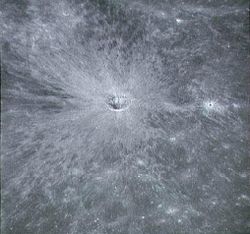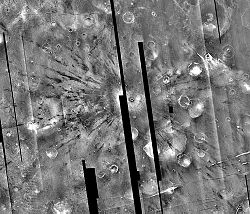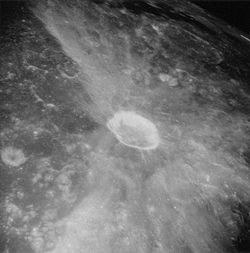
Ray system
Encyclopedia

Ejecta
Ejecta can mean:*In volcanology, particles that came out of a volcanic vent, traveled through the air or under water, and fell back on the ground surface or on the ocean floor...
thrown out during the formation of an impact crater
Impact crater
In the broadest sense, the term impact crater can be applied to any depression, natural or manmade, resulting from the high velocity impact of a projectile with a larger body...
, looking a bit like many thin spokes coming from the hub of a wheel. The rays can extend for lengths up to several times the diameter
Diameter
In geometry, a diameter of a circle is any straight line segment that passes through the center of the circle and whose endpoints are on the circle. The diameters are the longest chords of the circle...
of their originating crater, and are often accompanied by small secondary craters formed by larger chunks of ejecta. Ray systems have been identified on the Moon
Moon
The Moon is Earth's only known natural satellite,There are a number of near-Earth asteroids including 3753 Cruithne that are co-orbital with Earth: their orbits bring them close to Earth for periods of time but then alter in the long term . These are quasi-satellites and not true moons. For more...
, Mercury
Mercury (planet)
Mercury is the innermost and smallest planet in the Solar System, orbiting the Sun once every 87.969 Earth days. The orbit of Mercury has the highest eccentricity of all the Solar System planets, and it has the smallest axial tilt. It completes three rotations about its axis for every two orbits...
, and some moons
Natural satellite
A natural satellite or moon is a celestial body that orbits a planet or smaller body, which is called its primary. The two terms are used synonymously for non-artificial satellites of planets, of dwarf planets, and of minor planets....
of the outer planets. Originally it was thought that they existed only on planet
Planet
A planet is a celestial body orbiting a star or stellar remnant that is massive enough to be rounded by its own gravity, is not massive enough to cause thermonuclear fusion, and has cleared its neighbouring region of planetesimals.The term planet is ancient, with ties to history, science,...
s or moons lacking an atmosphere, but more recently they've been found on Mars
Mars
Mars is the fourth planet from the Sun in the Solar System. The planet is named after the Roman god of war, Mars. It is often described as the "Red Planet", as the iron oxide prevalent on its surface gives it a reddish appearance...
in infrared images taken from orbit by Mars Odyssey's thermal imager
Thermal Emission Imaging System
The Thermal Emission Imaging System is a camera on board the 2001 Mars Odyssey orbiter. It images Mars in the visible and infrared parts of the electromagnetic spectrum in order to determine the thermal properties of the surface and to refine the distribution of minerals on the surface of Mars as...
.

Albedo
Albedo , or reflection coefficient, is the diffuse reflectivity or reflecting power of a surface. It is defined as the ratio of reflected radiation from the surface to incident radiation upon it...
) or thermal properties from the surface on which they are deposited. Typically, visible rays have a higher albedo than the surrounding surface. More rarely an impact will excavate low albedo material, for example basalt
Basalt
Basalt is a common extrusive volcanic rock. It is usually grey to black and fine-grained due to rapid cooling of lava at the surface of a planet. It may be porphyritic containing larger crystals in a fine matrix, or vesicular, or frothy scoria. Unweathered basalt is black or grey...
ic-lava
Lava
Lava refers both to molten rock expelled by a volcano during an eruption and the resulting rock after solidification and cooling. This molten rock is formed in the interior of some planets, including Earth, and some of their satellites. When first erupted from a volcanic vent, lava is a liquid at...
deposits on the lunar maria
Lunar mare
The lunar maria are large, dark, basaltic plains on Earth's Moon, formed by ancient volcanic eruptions. They were dubbed maria, Latin for "seas", by early astronomers who mistook them for actual seas. They are less reflective than the "highlands" as a result of their iron-rich compositions, and...
. Thermal rays, as seen on Mars, are especially apparent at night when slopes and shadows do not influence the infrared energy emitted by the Martian surface.
The layering of rays across other surface features can be useful as an indicator of the relative age of the impact crater, because over time various processes obliterate the rays. On non-atmosphered bodies such as the Moon, space weathering
Space weathering
Space weathering is a blanket term used for a number of processes that act on any body exposed to the harsh space environment. Airless bodies incur many weathering processes:* collisions of galactic cosmic rays and solar cosmic rays,* irradiation, implantation, and sputtering from solar wind...
from exposure to cosmic ray
Cosmic ray
Cosmic rays are energetic charged subatomic particles, originating from outer space. They may produce secondary particles that penetrate the Earth's atmosphere and surface. The term ray is historical as cosmic rays were thought to be electromagnetic radiation...
s and micrometeorite
METEOR
METEOR is a metric for the evaluation of machine translation output. The metric is based on the harmonic mean of unigram precision and recall, with recall weighted higher than precision...
s causes a steady reduction of the differential between the ejecta's albedo and that of the underlying material. Micrometeorites in particular produce a glassy melt in the regolith
Regolith
Regolith is a layer of loose, heterogeneous material covering solid rock. It includes dust, soil, broken rock, and other related materials and is present on Earth, the Moon, some asteroids, and other terrestrial planets and moons.-Etymology:...
that lowers the albedo
Albedo
Albedo , or reflection coefficient, is the diffuse reflectivity or reflecting power of a surface. It is defined as the ratio of reflected radiation from the surface to incident radiation upon it...
. Rays can also become covered by lava
Lava
Lava refers both to molten rock expelled by a volcano during an eruption and the resulting rock after solidification and cooling. This molten rock is formed in the interior of some planets, including Earth, and some of their satellites. When first erupted from a volcanic vent, lava is a liquid at...
flows, or by other impact craters or ejecta.
Lunar rays

Recent studies suggest that the relative brightness of a lunar ray system is not always a reliable indicator of the age of a ray system. Instead the albedo also depends on the portion of iron oxide
Iron oxide
Iron oxides are chemical compounds composed of iron and oxygen. All together, there are sixteen known iron oxides and oxyhydroxides.Iron oxides and oxide-hydroxides are widespread in nature, play an important role in many geological and biological processes, and are widely utilized by humans, e.g.,...
(FeO). Low portions of FeO result in brighter materials, so such a ray system can retain its lighter appearance for longer periods. Thus the material composition needs to be factored into the albedo analysis to determine age.
Among the lunar craters on the near side with pronounced ray systems are Aristarchus
Aristarchus (crater)
Aristarchus is a prominent lunar impact crater that lies in the northwest part of the Moon's near side. It is considered the brightest of the large formations on the lunar surface, with an albedo nearly double that of most lunar features. The feature is bright enough to be visible to the naked eye,...
, Copernicus
Copernicus (lunar crater)
Copernicus is a prominent lunar impact crater named after the astronomer Nicolaus Copernicus, located in eastern Oceanus Procellarum. It is estimated to be about 800 million years old, and typifies craters that formed during the Copernican period in that it has a prominent ray system.-...
, Kepler
Kepler (lunar crater)
Kepler is a lunar impact crater that lies between the Oceanus Procellarum to the west and Mare Insularum in the east. To the southeast is the crater Encke....
, Proclus
Proclus (crater)
Proclus is a young lunar impact crater located to the west of the Mare Crisium, on the east shore of the Palus Somni. It lies to the south of the prominent, terraced crater Macrobius, and west-northwest of the lava-flooded Yerkes...
, and Tycho
Tycho (crater)
Tycho is a prominent lunar impact crater located in the southern lunar highlands, named after the Danish astronomer Tycho Brahe . To the south is the crater Street; to the east is Pictet, and to the north-northeast is Sasserides. The surface around Tycho is replete with craters of various sizes,...
. Similar ray systems also occur on the far side of the Moon, such as the rays radiating from the craters Giordano Bruno
Giordano Bruno (crater)
Giordano Bruno is a 22 km lunar impact crater on the far side of the Moon, just beyond the northeastern limb. At this location it lies in an area that can be viewed during a favorable libration, although at such times the area is viewed from the side and not much detail can be seen...
and Ohm
Ohm (crater)
Ohm is a lunar impact crater that is located on the far side of the Moon. It lies to the south of the crater Comrie, and the satellite crater Comrie K is attached to Ohm's northeastern rim...
.

